McDonald's Operations Management: Strategy, Decisions, and Analysis
VerifiedAdded on 2023/06/07
|7
|1358
|279
Report
AI Summary
This report provides an analysis of McDonald's operational strategy, innovation, decision-making processes, product and service design, process design, supply chain, planning and control, and quality management. It highlights McDonald's focus on standardization, affordability, speed, and quality, supported by a democratic leadership style and responsiveness to clients and franchisees. The company uses a uniform menu, with ongoing R&D for innovation, such as new product launches in China. Quality is evaluated throughout the franchise chain using 'mystery shoppers,' and the company utilizes a value chain approach with primary activities including inbound logistics, operations, outbound logistics, marketing and sales, and service. Statistical data is used for demand forecasting, and the company uses Six Sigma for quality management. The report concludes that McDonald's success is attributed to its inclusive decision-making process and its commitment to standardized, affordable, speedy, and high-quality products.
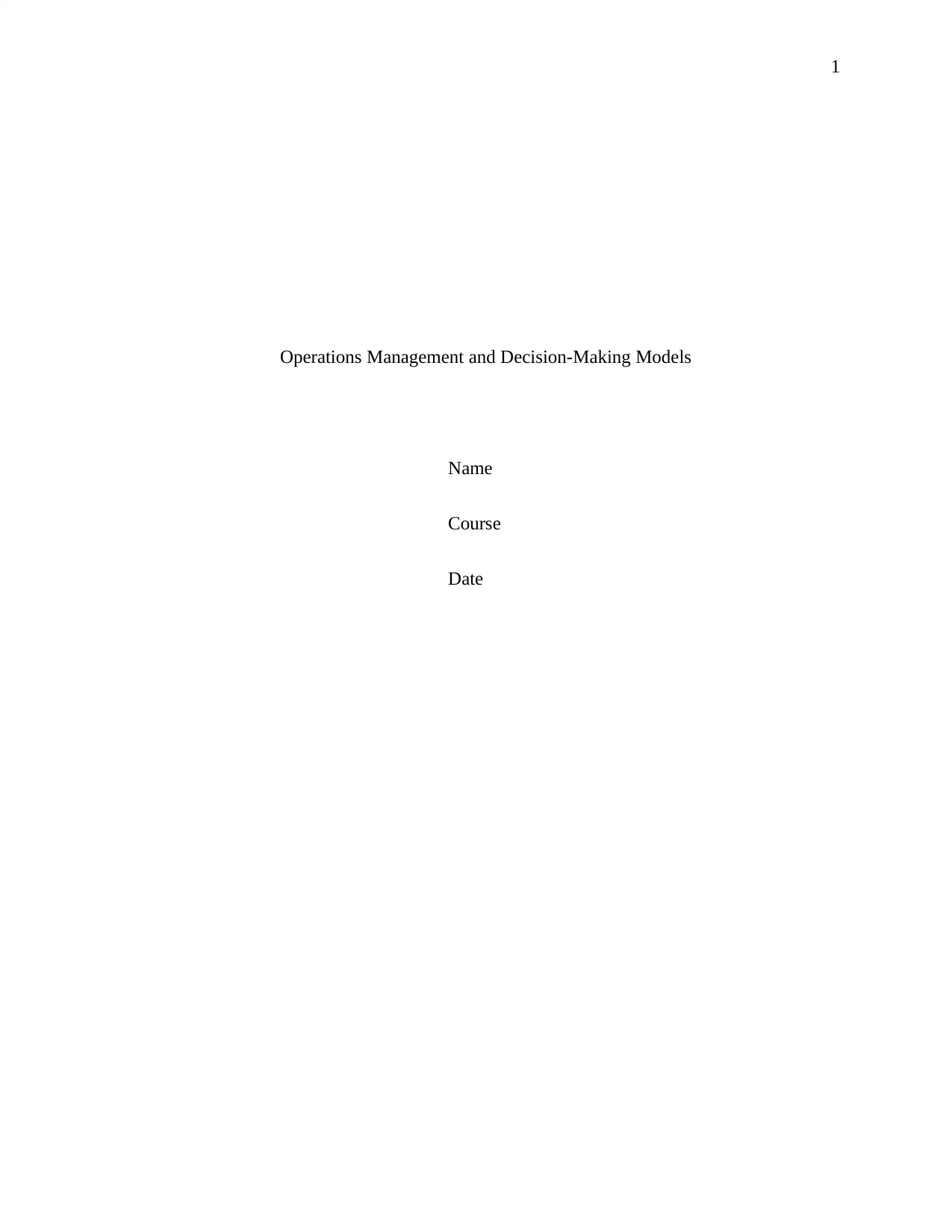
1
Operations Management and Decision-Making Models
Name
Course
Date
Operations Management and Decision-Making Models
Name
Course
Date
Paraphrase This Document
Need a fresh take? Get an instant paraphrase of this document with our AI Paraphraser

2
Introduction
McDonald’s is the leading and the most successful fast-food restaurant globally. The
corporation is well-known for its burgers which were introduced in 1940 by Dick and
McDonald. The company operates in more than 30, 000 franchised stores globally. The aim of
this report is to analyze the company’s operation strategy, innovation and the decision-making
process, product and service design, process design, supply chain, planning and control, and its
quality management.
Description of the Organization
McDonald’s was started in 1948 by Dick and McDonald. The corporation is the biggest
and the leading fast-food restaurant internationally, with its stores in more than 119 countries.
The corporation’s purpose includes providing customers with healthy, good-tasting food, and
encourage a good working environment for its employees.1 McDonald’s business strategy entails
providing excellent customer service, luring price sensitive clients by creating the value for
money, menu standardization, brand marketing, digital marketing, and offering an expanded
breakfast menu items.
Operations Strategy
The corporation utilizes a clear and excellent operations strategy with the intention of
gaining a larger market share as well as increasing the shareholders’ value. The company’s main
focus includes standardization, affordability, speed, and quality. McDonald’s operations strategy
has evolved such that it anticipates the consumers’ traffic patterns as well as the selection of food
1 Xu, Yueying, Understanding CSR, 1012.
Introduction
McDonald’s is the leading and the most successful fast-food restaurant globally. The
corporation is well-known for its burgers which were introduced in 1940 by Dick and
McDonald. The company operates in more than 30, 000 franchised stores globally. The aim of
this report is to analyze the company’s operation strategy, innovation and the decision-making
process, product and service design, process design, supply chain, planning and control, and its
quality management.
Description of the Organization
McDonald’s was started in 1948 by Dick and McDonald. The corporation is the biggest
and the leading fast-food restaurant internationally, with its stores in more than 119 countries.
The corporation’s purpose includes providing customers with healthy, good-tasting food, and
encourage a good working environment for its employees.1 McDonald’s business strategy entails
providing excellent customer service, luring price sensitive clients by creating the value for
money, menu standardization, brand marketing, digital marketing, and offering an expanded
breakfast menu items.
Operations Strategy
The corporation utilizes a clear and excellent operations strategy with the intention of
gaining a larger market share as well as increasing the shareholders’ value. The company’s main
focus includes standardization, affordability, speed, and quality. McDonald’s operations strategy
has evolved such that it anticipates the consumers’ traffic patterns as well as the selection of food
1 Xu, Yueying, Understanding CSR, 1012.
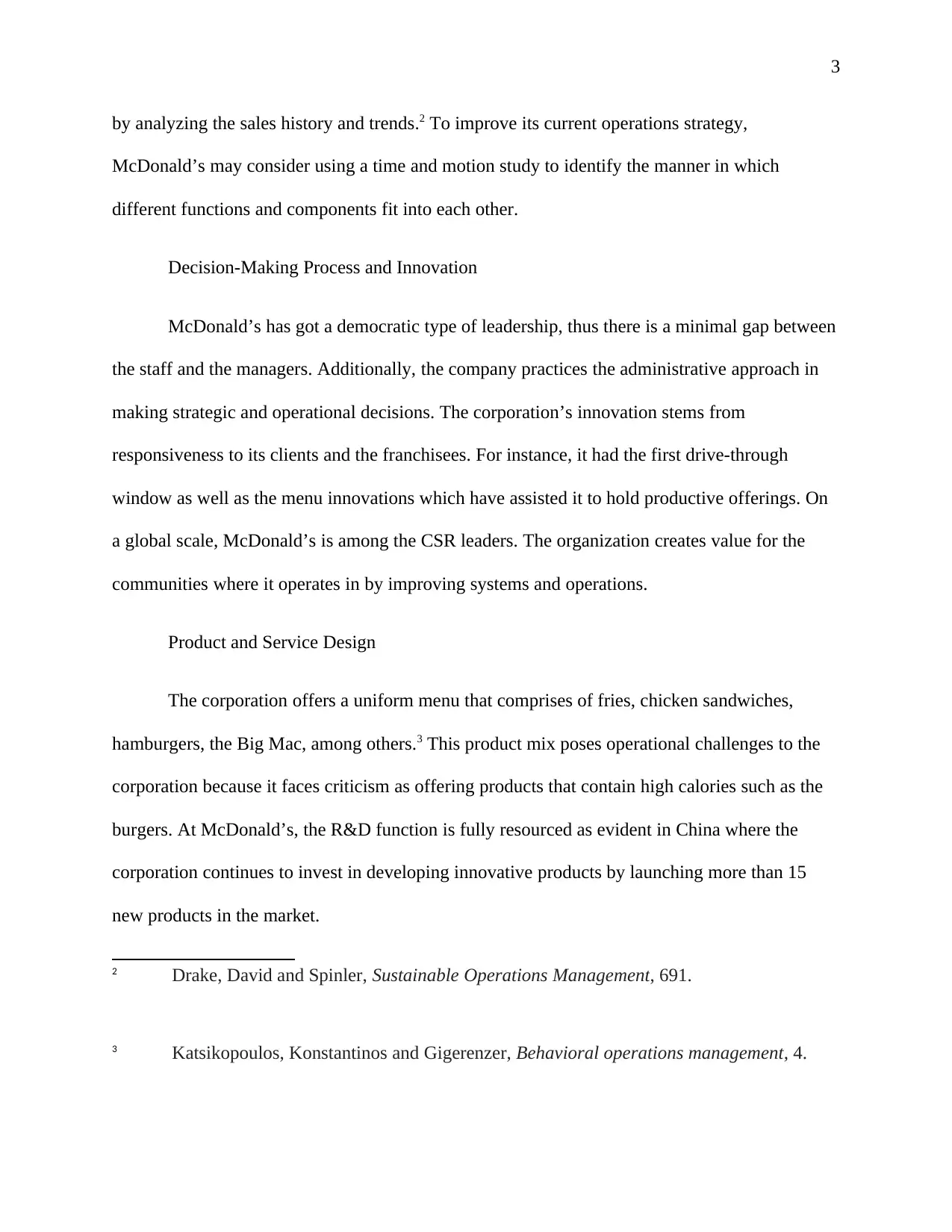
3
by analyzing the sales history and trends.2 To improve its current operations strategy,
McDonald’s may consider using a time and motion study to identify the manner in which
different functions and components fit into each other.
Decision-Making Process and Innovation
McDonald’s has got a democratic type of leadership, thus there is a minimal gap between
the staff and the managers. Additionally, the company practices the administrative approach in
making strategic and operational decisions. The corporation’s innovation stems from
responsiveness to its clients and the franchisees. For instance, it had the first drive-through
window as well as the menu innovations which have assisted it to hold productive offerings. On
a global scale, McDonald’s is among the CSR leaders. The organization creates value for the
communities where it operates in by improving systems and operations.
Product and Service Design
The corporation offers a uniform menu that comprises of fries, chicken sandwiches,
hamburgers, the Big Mac, among others.3 This product mix poses operational challenges to the
corporation because it faces criticism as offering products that contain high calories such as the
burgers. At McDonald’s, the R&D function is fully resourced as evident in China where the
corporation continues to invest in developing innovative products by launching more than 15
new products in the market.
2 Drake, David and Spinler, Sustainable Operations Management, 691.
3 Katsikopoulos, Konstantinos and Gigerenzer, Behavioral operations management, 4.
by analyzing the sales history and trends.2 To improve its current operations strategy,
McDonald’s may consider using a time and motion study to identify the manner in which
different functions and components fit into each other.
Decision-Making Process and Innovation
McDonald’s has got a democratic type of leadership, thus there is a minimal gap between
the staff and the managers. Additionally, the company practices the administrative approach in
making strategic and operational decisions. The corporation’s innovation stems from
responsiveness to its clients and the franchisees. For instance, it had the first drive-through
window as well as the menu innovations which have assisted it to hold productive offerings. On
a global scale, McDonald’s is among the CSR leaders. The organization creates value for the
communities where it operates in by improving systems and operations.
Product and Service Design
The corporation offers a uniform menu that comprises of fries, chicken sandwiches,
hamburgers, the Big Mac, among others.3 This product mix poses operational challenges to the
corporation because it faces criticism as offering products that contain high calories such as the
burgers. At McDonald’s, the R&D function is fully resourced as evident in China where the
corporation continues to invest in developing innovative products by launching more than 15
new products in the market.
2 Drake, David and Spinler, Sustainable Operations Management, 691.
3 Katsikopoulos, Konstantinos and Gigerenzer, Behavioral operations management, 4.
⊘ This is a preview!⊘
Do you want full access?
Subscribe today to unlock all pages.

Trusted by 1+ million students worldwide
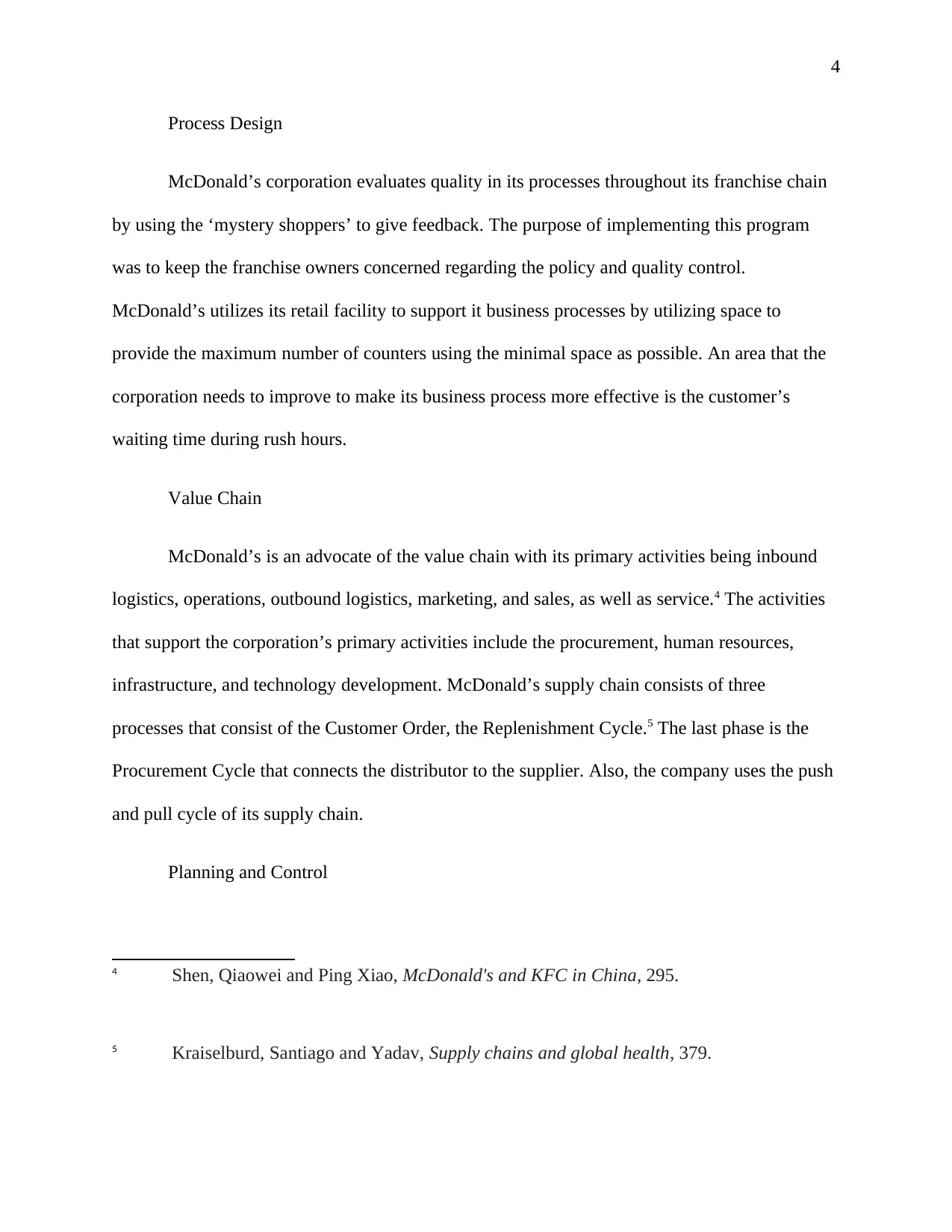
4
Process Design
McDonald’s corporation evaluates quality in its processes throughout its franchise chain
by using the ‘mystery shoppers’ to give feedback. The purpose of implementing this program
was to keep the franchise owners concerned regarding the policy and quality control.
McDonald’s utilizes its retail facility to support it business processes by utilizing space to
provide the maximum number of counters using the minimal space as possible. An area that the
corporation needs to improve to make its business process more effective is the customer’s
waiting time during rush hours.
Value Chain
McDonald’s is an advocate of the value chain with its primary activities being inbound
logistics, operations, outbound logistics, marketing, and sales, as well as service.4 The activities
that support the corporation’s primary activities include the procurement, human resources,
infrastructure, and technology development. McDonald’s supply chain consists of three
processes that consist of the Customer Order, the Replenishment Cycle.5 The last phase is the
Procurement Cycle that connects the distributor to the supplier. Also, the company uses the push
and pull cycle of its supply chain.
Planning and Control
4 Shen, Qiaowei and Ping Xiao, McDonald's and KFC in China, 295.
5 Kraiselburd, Santiago and Yadav, Supply chains and global health, 379.
Process Design
McDonald’s corporation evaluates quality in its processes throughout its franchise chain
by using the ‘mystery shoppers’ to give feedback. The purpose of implementing this program
was to keep the franchise owners concerned regarding the policy and quality control.
McDonald’s utilizes its retail facility to support it business processes by utilizing space to
provide the maximum number of counters using the minimal space as possible. An area that the
corporation needs to improve to make its business process more effective is the customer’s
waiting time during rush hours.
Value Chain
McDonald’s is an advocate of the value chain with its primary activities being inbound
logistics, operations, outbound logistics, marketing, and sales, as well as service.4 The activities
that support the corporation’s primary activities include the procurement, human resources,
infrastructure, and technology development. McDonald’s supply chain consists of three
processes that consist of the Customer Order, the Replenishment Cycle.5 The last phase is the
Procurement Cycle that connects the distributor to the supplier. Also, the company uses the push
and pull cycle of its supply chain.
Planning and Control
4 Shen, Qiaowei and Ping Xiao, McDonald's and KFC in China, 295.
5 Kraiselburd, Santiago and Yadav, Supply chains and global health, 379.
Paraphrase This Document
Need a fresh take? Get an instant paraphrase of this document with our AI Paraphraser
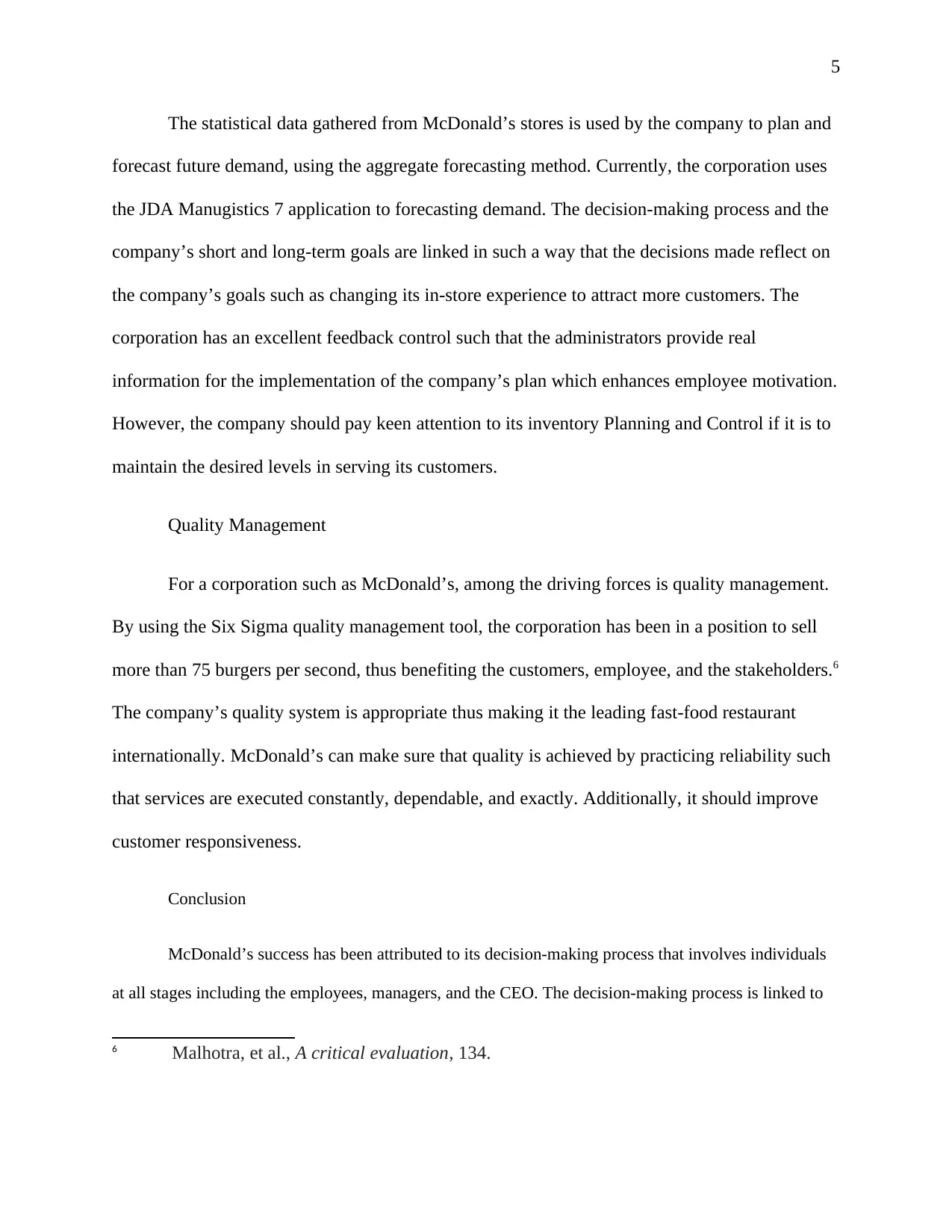
5
The statistical data gathered from McDonald’s stores is used by the company to plan and
forecast future demand, using the aggregate forecasting method. Currently, the corporation uses
the JDA Manugistics 7 application to forecasting demand. The decision-making process and the
company’s short and long-term goals are linked in such a way that the decisions made reflect on
the company’s goals such as changing its in-store experience to attract more customers. The
corporation has an excellent feedback control such that the administrators provide real
information for the implementation of the company’s plan which enhances employee motivation.
However, the company should pay keen attention to its inventory Planning and Control if it is to
maintain the desired levels in serving its customers.
Quality Management
For a corporation such as McDonald’s, among the driving forces is quality management.
By using the Six Sigma quality management tool, the corporation has been in a position to sell
more than 75 burgers per second, thus benefiting the customers, employee, and the stakeholders.6
The company’s quality system is appropriate thus making it the leading fast-food restaurant
internationally. McDonald’s can make sure that quality is achieved by practicing reliability such
that services are executed constantly, dependable, and exactly. Additionally, it should improve
customer responsiveness.
Conclusion
McDonald’s success has been attributed to its decision-making process that involves individuals
at all stages including the employees, managers, and the CEO. The decision-making process is linked to
6 Malhotra, et al., A critical evaluation, 134.
The statistical data gathered from McDonald’s stores is used by the company to plan and
forecast future demand, using the aggregate forecasting method. Currently, the corporation uses
the JDA Manugistics 7 application to forecasting demand. The decision-making process and the
company’s short and long-term goals are linked in such a way that the decisions made reflect on
the company’s goals such as changing its in-store experience to attract more customers. The
corporation has an excellent feedback control such that the administrators provide real
information for the implementation of the company’s plan which enhances employee motivation.
However, the company should pay keen attention to its inventory Planning and Control if it is to
maintain the desired levels in serving its customers.
Quality Management
For a corporation such as McDonald’s, among the driving forces is quality management.
By using the Six Sigma quality management tool, the corporation has been in a position to sell
more than 75 burgers per second, thus benefiting the customers, employee, and the stakeholders.6
The company’s quality system is appropriate thus making it the leading fast-food restaurant
internationally. McDonald’s can make sure that quality is achieved by practicing reliability such
that services are executed constantly, dependable, and exactly. Additionally, it should improve
customer responsiveness.
Conclusion
McDonald’s success has been attributed to its decision-making process that involves individuals
at all stages including the employees, managers, and the CEO. The decision-making process is linked to
6 Malhotra, et al., A critical evaluation, 134.
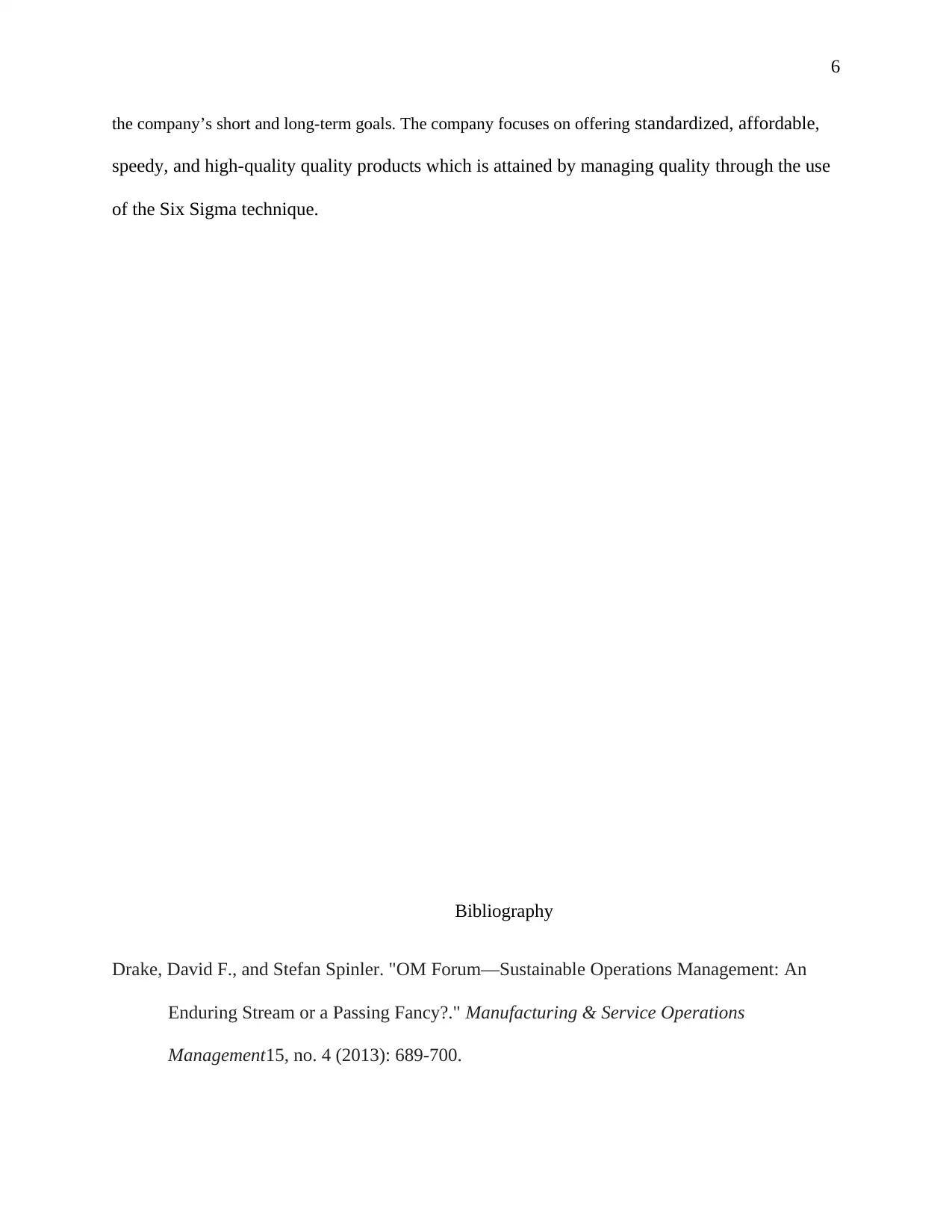
6
the company’s short and long-term goals. The company focuses on offering standardized, affordable,
speedy, and high-quality quality products which is attained by managing quality through the use
of the Six Sigma technique.
Bibliography
Drake, David F., and Stefan Spinler. "OM Forum—Sustainable Operations Management: An
Enduring Stream or a Passing Fancy?." Manufacturing & Service Operations
Management15, no. 4 (2013): 689-700.
the company’s short and long-term goals. The company focuses on offering standardized, affordable,
speedy, and high-quality quality products which is attained by managing quality through the use
of the Six Sigma technique.
Bibliography
Drake, David F., and Stefan Spinler. "OM Forum—Sustainable Operations Management: An
Enduring Stream or a Passing Fancy?." Manufacturing & Service Operations
Management15, no. 4 (2013): 689-700.
⊘ This is a preview!⊘
Do you want full access?
Subscribe today to unlock all pages.

Trusted by 1+ million students worldwide

7
Katsikopoulos, Konstantinos V., and Gerd Gigerenzer. "Behavioral operations management: A
blind spot and a research program." Journal of Supply Chain Management 49, no. 1
(2013): 3-7.
Kraiselburd, Santiago, and Prashant Yadav. "Supply chains and global health: an imperative for
bringing operations management scholarship into action." Production and operations
management 22, no. 2 (2013): 377-381.
Malhotra, Manoj K., Cherry Singhal, Guangzhi Shang, and Robert E. Ployhart. "A critical
evaluation of alternative methods and paradigms for conducting mediation analysis in
operations management research." Journal of Operations Management 32, no. 4 (2014):
127-137.
Shen, Qiaowei, and Ping Xiao. "McDonald's and KFC in China: Competitors or
Companions?." Marketing Science 33, no. 2 (2014): 287-307.
Xu, Yueying. "Understanding CSR from the perspective of Chinese diners: the case of
McDonald’s." International Journal of Contemporary Hospitality Management 26, no. 6
(2014): 1002-1020.
Katsikopoulos, Konstantinos V., and Gerd Gigerenzer. "Behavioral operations management: A
blind spot and a research program." Journal of Supply Chain Management 49, no. 1
(2013): 3-7.
Kraiselburd, Santiago, and Prashant Yadav. "Supply chains and global health: an imperative for
bringing operations management scholarship into action." Production and operations
management 22, no. 2 (2013): 377-381.
Malhotra, Manoj K., Cherry Singhal, Guangzhi Shang, and Robert E. Ployhart. "A critical
evaluation of alternative methods and paradigms for conducting mediation analysis in
operations management research." Journal of Operations Management 32, no. 4 (2014):
127-137.
Shen, Qiaowei, and Ping Xiao. "McDonald's and KFC in China: Competitors or
Companions?." Marketing Science 33, no. 2 (2014): 287-307.
Xu, Yueying. "Understanding CSR from the perspective of Chinese diners: the case of
McDonald’s." International Journal of Contemporary Hospitality Management 26, no. 6
(2014): 1002-1020.
1 out of 7
Related Documents
Your All-in-One AI-Powered Toolkit for Academic Success.
+13062052269
info@desklib.com
Available 24*7 on WhatsApp / Email
![[object Object]](/_next/static/media/star-bottom.7253800d.svg)
Unlock your academic potential
Copyright © 2020–2025 A2Z Services. All Rights Reserved. Developed and managed by ZUCOL.




